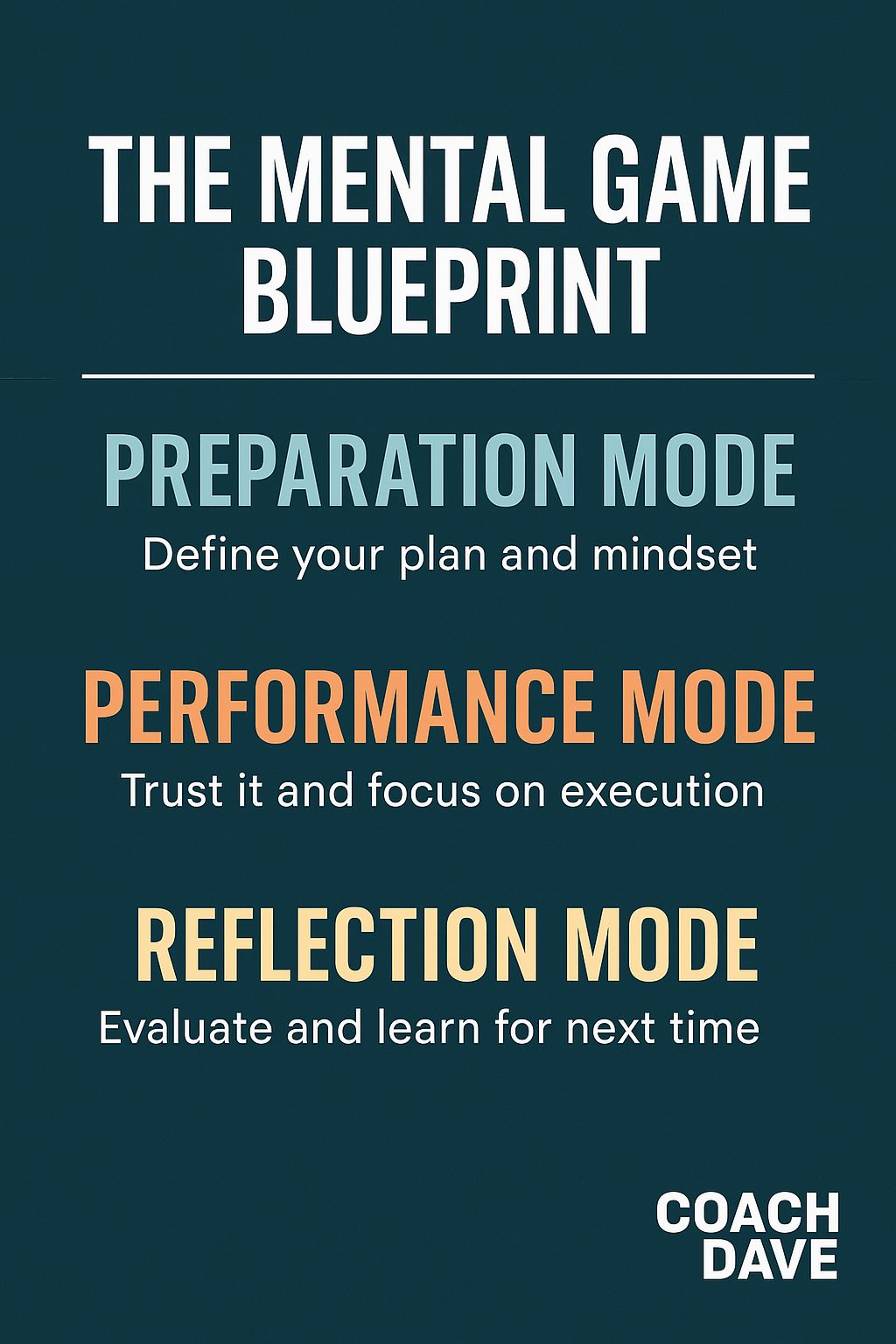- Coach Dave
- Posts
- The Mental Game Blueprint: How to Simplify Your Mindset and Perform at Your Best
The Mental Game Blueprint: How to Simplify Your Mindset and Perform at Your Best
By Coach Dave

Every athlete wants to play with confidence, consistency, and control. But here’s the challenge, the mental game can feel complicated and abstract.
You’ve probably heard advice like “just be confident” or “trust the process.” It sounds good… but it rarely helps.
That’s because mindset isn’t built from clichés, it’s built from clarity, repetition, and systems that make sense to you.
I teach athletes how to make the mental game simple, practical, and personal. The goal isn’t to “think more” it’s to align your thoughts, emotions, and actions so you can perform freely and consistently.
Let’s break down the framework I use with my athletes, what I call The Mental Game Blueprint.
It’s built on three phases: Preparation Mode, Performance Mode, and Reflection Mode.
Each one builds on the next. Let’s walk through them.
Phase 1: Preparation Mode
This is where your mindset work begins, before the game ever starts.
Most athletes skip this step, and it costs them when pressure hits.
Preparation Mode is where you design your mental game plan, how you want to think, feel, and act when you compete.
Here’s what it includes:
1. Your Story (Your Why)
Every athlete has a moment that made them fall in love with their sport, a time when it was pure fun, no pressure, no expectations.
Reconnect with that memory.
That story becomes your emotional anchor, a reminder of why you play and the feeling you want to bring into every practice or game.
2. Pressure Planning
You can’t avoid adversity, you can only prepare for it.
What situations throw you off most? A bad call? A missed shot? A mistake in front of a crowd?
List your “mental traps,” then decide now how you’ll respond.
This is your mental version of game film, anticipate, plan, and respond intentionally.
3. Identity Traits (Your Pillars)
Who do you want to be out there? Calm? Relentless? Fearless?
These are your Performance Pillars — the traits you choose to embody every time you compete.
When you define them clearly, you can activate them, that’s where your Performance Identity or “alter ego” comes to life.
💡 Pro tip: Take 5–10 minutes before each game to visualize your story, your plan, and your pillars. You’re not just thinking about the game — you’re programming your mindset for it.
Phase 2: Performance Mode
Now it’s time to let go and trust it.
The biggest mistake athletes make? Overthinking.
If you’ve done the work in Phase 1, your only job in Performance Mode is to get out of your own way.
Here’s how to do it:
1. Trust Over Control
You can’t control every bounce, whistle, or outcome, but you can control your response.
Elite athletes don’t try to force performance, they allow it. They “let it happen,” not “make it happen.”
2. Respond, Don’t React
Mistakes happen. Emotions spike. The difference between average and elite is how fast you reset.
Create a Reset Routine, a 10-second sequence to clear your head and refocus.
It could be:
One deep breath
A short cue (“Next Play” or “I’m good”)
A physical trigger (like tapping your chest or fixing your jersey)
This resets your focus and reactivates your performance identity.
3. Stay Adaptable
Games rarely go as planned.
Champions don’t crumble, they adjust.
Adopt a “bring it on” mindset. Instead of fearing chaos, welcome it.
That adaptability keeps you in control when everyone else is unraveling.
Remember, Performance Mode isn’t about perfection, it’s about freedom.
Play loose. Trust your work. Compete with presence.
Phase 3: Reflection Mode
The work doesn’t end when the final buzzer sounds.
The best athletes don’t just move on, they learn fast.
Reflection Mode is where growth happens.
It’s not about judging results, it’s about evaluating your mindset, your focus, and your process.
Here’s how to reflect effectively:
1. Celebrate Wins
No matter how the game went, find what went right.
Confidence grows when you acknowledge progress, not just perfection.
Make it a habit to “own your wins” after every game.
2. Study Your Process
Instead of obsessing over stats, ask:
How well did I stick to my reset routine?
Did I stay connected to my pillars?
Did I play free or play tight?
Reflection is about learning, not judging.
3. Park It & Move On
Don’t carry the last game into the next one.
Write your reflections down, a short journal entry works wonders.
Once you’ve learned what you need, let it go.
Putting It All Together
When you combine these three phases — Prepare, Perform, Reflect — you create a mental system that’s simple, powerful, and repeatable.
You don’t need 100 mental hacks. You need a plan you can actually use.
So here’s your challenge:
This week, commit to using all three phases before, during, and after your games. Track your streak, can you go 5-for-5 in one week?
You’ll be amazed how quickly your mindset sharpens and your confidence grows when you do it with consistency.
Because mental toughness isn’t built overnight, it’s built through daily reps of mental preparation, presence, and reflection.
If you’d like help creating your personalized Mental Game Blueprint, message me directly. I’ll share the same framework I use with athletes to build confidence, calm, and consistency under pressure.
— Coach Dave
Helping athletes build the mental game to play fearless, focused, and free.